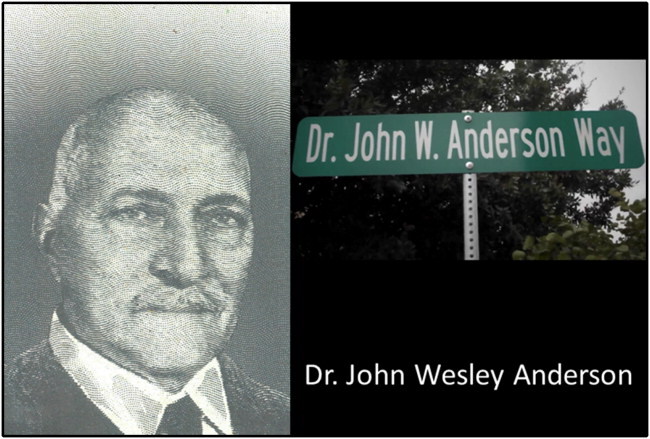
In my capacity as a member of the Board of Managers for Parkland Health, I recently attended a ceremony in honor of the naming of a street, Dr. John Wesley Anderson Way, located on the campus of Parkland Hospital in Dallas. In doing so, I was able to learn about Dr. John Wesley Anderson and his dedication to improving the lives of Blacks in Dallas.
Dr. John Wesley Anderson was an African American dentist in Dallas. He was the biracial son of a Caucasian British man and of his mother, a former African slave. Dr. Anderson attended dental school at Meharry Medical College in Nashville, Tennessee, one of the two dental schools in the United States available for education of Blacks in the mid 1800s. After graduation from dental school, Dr. Anderson moved to Dallas, and on July 13, 1888, he began his dental practice. He was the third Black doctor to practice in the city of Dallas, following fellow Meharry graduates Dr. Benjamin Bluitt and Dr. Monroe Majors.
Dr. Anderson possessed a characteristic that allowed him an advantage over the other two Black doctors in Dallas at the time. As a biracial doctor, Dr. Anderson had a very light complexion for a Black person and was able to “pass” as being perceived as a White doctor. In those days, Black doctors were not granted access to practice in mainstream Dallas medical facilities. However, as Dr. Anderson was able to “pass” as being White, he was able to travel extensively throughout the city of Dallas offering dental care to treat both the “elite” and the poor. Through the money that Dr. Anderson collected from being able to treat a broad patient population, he acquired significantly more income than other Black doctors in Dallas. Dr. Anderson used that income to reinvest in prime real estate and to acquire more wealth. He then invested in causes that supported the Black community of Dallas.
Through his multifaceted initiatives and unwavering commitment, he worked assiduously to dismantle systemic barriers and uplift the quality of life for Blacks in Dallas. He founded specialized scholarship funds, mentorship initiatives, and academic support networks. He provided vital resources and guidance to young individuals striving to overcome socioeconomic obstacles and obtain meaningful progress and social mobility.
He acquired land outside of the city limits that he used as a housing project named “Lincoln Manor” which provided an opportunity for Blacks in Dallas to own land. He donated thousands of dollars to support college education at Wiley College, a historically Black College and University (HBCU) in Texas. He contributed funds to his alma mater dental school, Meharry Medical College, one of the major HBCUs to train African American physicians and dentists in the US. He was a lifelong supporter of the YMCA, donating land and cash to provide 253 memberships for Blacks in Dallas to support their health and socioeconomic mobility. By 1938, he had given over $18,000 to the YMCA.
Dr. Anderson’s community-based initiatives focused on creating sustainable pathways for economic empowerment and entrepreneurial development within the Dallas Black population. By establishing small business incubators, vocational training programs, and financial literacy workshops, he equipped individuals with the necessary tools to achieve financial independence and long-term stability. Dr. Anderson’s unwavering dedication to improving the lives of Blacks in Dallas has established a resilient foundation for continued progress and prosperity, inspiring future generations to carry forward his legacy of empowerment and social change.
In British folklore, Robin Hood was a hero who robbed the rich to give to the poor. Dr. Anderson was the “Dr. Robin Hood” of his day. It is ironic that Dr. Anderson was a British descendant who used his special characteristic of appearing to be White, but actually being Black, as a tool to transfer wealth and empower the Black community of Dallas. I am so glad that I had the opportunity to learn about Dr. Robert Wesley Anderson. He was a great doctor and an important figure in the history of Blacks in Dallas.
Department of Internal Medicine, Baylor University Medical Center, Dallas, Texas, USA
[email protected]
http://orcid.org/0000-0003-1706-1961
Conflict of interest
Byron Cryer, MD, reports a potential conflict of interest as he serves as a member of the Board of Managers for Parkland Health. The Dallas County Hospital District, doing business as Parkland Health, is governed by an 11-member Board of Managers appointed by the Dallas County Commissioners Court. The Board is responsible for governing policies and also has budgetary oversight for the hospital district.
DISCLOSURE STATEMENT
Byron Cryer, MD, reports a potential conflict of interest as he serves as a member of the Board of Managers for Parkland Health. The Dallas County Hospital District, doing business as Parkland Health, is governed by an 11-member Board of Managers appointed by the Dallas County Commissioners Court. The Board is responsible for governing policies and also has budgetary oversight for the hospital district.
